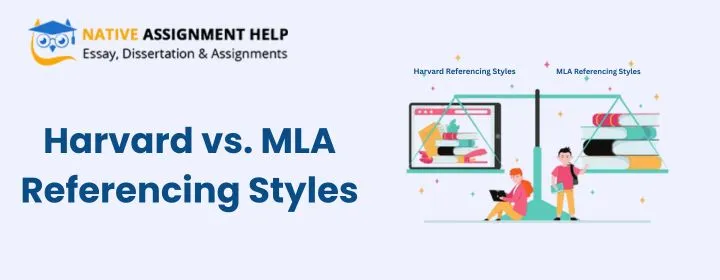
Harvard Vs. MLA Referencing Styles: Your Complete Guide With Examples
“Make Sure to cite the sources in Harvard style?” Whether you are a university student, academic writer or even a researcher publishing your work, it's vital to take note of the referencing of sources. Without them, your work would be marked as unethical copyright infringement, or commonly referred to as plagiarism. Hence, the references are vital, but there is a wide range of such referencing styles. They can commonly include MLA (Modern Language Association), APA (American Psychological Association), Harvard, Chicago and Vancouver.
Among these, the most probable ones among the UK students are Harvard and MLA referencing styles. But, both of these styles are somewhat confusing, so here we have brought a guide to resolve any doubts involved with this. Continue reading through the blog post, and you will be ready to use such references by the end of it.
Overview Of The Harvard Referencing Style
Let's start by understanding the reference style itself. Since we are going to look through them both individually, you won’t have any doubts regarding them. Now, first up is the Harvard referencing style. As the name suggests, this style stems from Harvard University, where it is used to reference students' sources. A key thing to understand about the Harvard Referencing Style is that it's a parenthetical style. What does it mean? It means that the information to be pointed out, as in the source that has to be pointed out, is placed inside parentheses.;
Harvard style generally lists the author's name and publication date (author-date format), and in some cases, it can also include the specific page number(author-page format). Both cases are useful, with the prior one being more about the general use. The latter ones are used when the date is omitted. A simple example to showcase the style would be (Doe, 2021) or (Doe, 2021, p. 47). The names are inverted with surnames coming first, and p or pp being used for page.
Where it’s used- The Harvard referencing style is widely used across varied majors, including humanities, behavioural, natural and social science.
Overview Of The MLA Referencing Style
A bit different to one we already talked about, the MLA referencing style was created by the Modern Language Association. Its origin from the association itself specifies its use for literary works. It mostly uses an author name-page number format, as the date of publication isn’t as useful as quoting the exact page is important for the work. That’s why, even though it’s parenthetical style just like Harvard, it doesn’t have much focus for the publication date itself.
In case you have to quote a single author's work, you have to specify the page number where it was used. So, an example in the same context would be (Doe p. 47). But if you have to mention more than a single page where it was used, (Doe p. 47-49) would be more apt. That’s the gist of the MLA referencing Style.
Where it’s used- The MLA reference style is also used in the humanities, but mostly for subjects predominant in the arts and literature.
Key Differences in In-Text Citations and Focus
Now, both Harvard and MLA reference styles are parenthetical ones; however, that doesn’t make them similar. They have their differences, and that’s the main prospect of us doing a Harvard Vs MLA referencing style guide anyway. Here are these differences:
In Text Citation Format
Both Harvard and MLA are parenthetical styles, so they mention the sources in brackets. However, they vary in the way they do so. In Harvard style, the focus is on the author's name and publication date. So it uses an author-date format in the bracket. It also separates the two with a comma in between. On the other hand, MLA referencing style has no such requirements as it focuses on the page number of the quoted text primarily. Students have to mention author-page number, and it's not separated by a comma either; just a space in between them suffices.
Focus on date vs page
The difference between the in-text citation formation originates from the main focus of the research itself. Harvard generally focuses on STEM-based research, primarily in fields like science and social science. Here, the date of publication signifies how relevant and useful the study is, hence the need for the publication date in it. On the other hand, MLA style is more so for literary works, where the date isn't the primary concern. It's the source and especially its page from which the data was quoted.
References vs Quotations
For those students following the Harvard reference style, their bibliography at the end of the work is titled “References” or “References Used”. It lists all the varied sources that were used during the work and sometimes even the works that were consulted. On the other hand, in MLA style, the bibliography is titled “Works Cited.” It strictly limits the mentioned information to only the work quoted in it. If needed, the writer/researcher can add a bibliography in the next section.
Use of Footnotes
Harvard and MLA reference styles both have similar aspects in their parenthetical types. So generally, both styles don’t use footnotes. However, it’s only strictly prohibited in the case of the Harvard style. Any sources used or consulted are mentioned in the reference list. MLA style, on the other hand, allows for the separate footnotes after the works cited page, but not for standard citations of sources.
Some Examples Of Harvard Vs MLA Referencing Style For Better Understanding
Just the theory itself is not enough to understand how the Harvard vs MLA referencing style works. So here we have taken a unique approach to resolve the doubts, and that’s through showcasing clear examples about the different styles. Moreover, we have listed varied sources of different types to give clear differentiation through examples. Take a look.
Books
Referencing in Harvard: First, list the names of the Author, then the date of publication
In-text: (Bolman and Deal, 2017) – note the year in the citation.
Reference list: Bolman, L.G. and Deal, T.E., 2017. Reframing organisations: Artistry, choice, and leadership. John Wiley & Sons.
Referencing in MLA:
In-text: (Bolman and Deal 27) – assume we’re citing something from page 27; no year is given in-text.
Works Cited: Bolman, Lee G., and Terrence E. Deal. Reframing Organisations: Artistry, Choice, and Leadership. John Wiley & Sons, 2017
Journal Article (Print)
Referencing in Harvard style:
In-text: (Piper, 2009) – author and year.
Reference: Piper, A. (2009). “Rethinking the Print Object: Goethe and the Book of Everything.” PMLA, 132(1), pp. 118–125.
Referencing in MLA style:
In-text: (Piper 120) – if citing a specific page, e.g., page 120.
Works Cited: Piper, Andrew. “Rethinking the Print Object: Goethe and the Book of Everything.” PMLA, vol. 132, no. 1, 2009, pp. 118–125.
Website
Referencing in Harvard style:
In-text: (Doe, 2022) – if an author is known; if no author, use the organisation or title.
Reference: Doe, J. 2022. “How to Cite Sources.” CitationHelp.com. [Online]. Available at: https://www.citationhelp.com/how-to-cite [Accessed 5 Jan 2025].
Referencing in MLA Style:
In-text: (Doe) – MLA in-text for a web source with no page numbers may just have the author's name. If no author, use a shortened title in quotes.
Works Cited: Doe, Jane. “How to Cite Sources.” CitationHelp, 5 Jan. 2025, https://www.citationhelp.com/how-to-cite.
These examples illustrate the major differences between the Harvard and MLA referencing styles. Harvard citations consistently highlight the year of publication to showcase the relevance of the research source. On the contrary, MLA is more about quoting the exact page number as seen through the examples.
Pros And Cons Of Harvard Vs MLA Referencing Style
After understanding the details of both Harvard and MLA referencing styles, it is assured that both are effective at citing sources. However, what are the pros of these styles, and what are their cons? Well, that’s a point worth going through, so here we have done exactly that:
Harvard Referencing Style
Pros
Let's first take a look at the pros of using the Harvard referencing style. These include:
- Harvard has short in-text citations as it requires just mentioning the author's name and publication date. This makes it easy to cite the sources without affecting the flow of the research.
- Harvard referencing style is a widely used style among the most global majors. Moreover, it also provides a strong foundation for learning other styles. Plus, it doesn’t require footnotes, making it even easier for students.
- This reference style emphasises recent research as it is commonly used in the STEM-related fields. It specifies the publication year, making it clear for the audience to understand how relevant the source is to the topic.
Cons
- Harvard referencing style doesn’t have a strict standard. Most institutions have different rules for minor aspects in the references, such as where to use punctuation, where to italicise and so on. This makes it confusing.
- The in-text citations of the Harvard style are too basic and don’t offer any detailed info. They just mention the author's name and date, which, for subjects like literature, is confusing.
- In many cases, Harvard’s minimal reference style becomes a con as it doesn’t mention the medium and edition of the publication. If that information is vital for the readers, then its absence can adversely affect the readers' point of view.
MLA referencing style
Pros
- MLA referencing style is highly detailed and gives specific information regarding the source. In subjects like literature, where you need to analyse specific passages, it's a great source of information.
- MLA referencing style is standardised, and hence its details are easy to find. Students won't be confused facing it.
- Its detailed bibliographies are a major benefit for readers who want information about the specific quoted section or the page number itself.
Cons
- MLA referencing style doesn’t put emphasis on the date, which can be a con in case the quoted text is old and redundant.
- Its detailing aspect makes it longer and hence more difficult to reference all sources.
- MLA is rarely utilised outside of the humanities and literary majors. Hence, the students might have to learn other referencing styles too.
Worried About Correctly Citing Your Sources? Let Native Assignment Help UK Resolve It For You
And that’s it for the guide, learners. Harvard vs MLA referencing style has been a common challenge among students for a long time now. Hopefully, you have been able to enhance your understanding of citation policies with this work. But that’s not all there is for our assistance with citation tasks. We understand the gap between theoretical foundation and practical assistance. Hence, at Assignment Help UK, we extend our services to help you with the citation task itself. You can simply connect with any of our professional experts and they will take it upon themself to resolve your worries. Get right into it, hire a writer yourself.
I am PhD scholar with an education from Cardiff University. I have been evaluated by strict assessment criteria and still managed to get the best grades. If you are also facing similar issues, I assure you I can help you match your professor's demanding expectations



